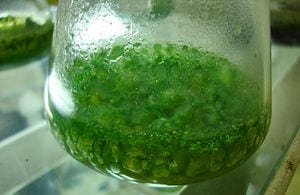
“The problem with a lot of clean-tech deals is that they have been about the way you make things in high volume or in production, which means you can’t prove out the ideas unless you build factories and actually make things in volume,”
STARTING when they became friends in freshman year at Emory University in Atlanta, Jonathan S. Wolfson and Harrison F. Dillon would take off into the mountains of Wyoming and Colorado for weeks at time. They spent their days hiking in the wilderness and their nights drinking bourbon by the campfire, talking big about how one day they would build a company that would help preserve the environment they both loved.
They graduated, and the backpacking trips grew shorter and further between. Mr. Dillon went on to earn a Ph.D. in genetics and a law degree, and ended up working as a biotech patent lawyer in Silicon Valley. Mr. Wolfson received law and business degrees from New York University and eventually started a software business. But the two still got together every year. And they kept talking about the company that, they imagined as time went on, would use biotechnology to create renewable energy.
“These were delusional rantings of kids,” said Mr. Wolfson, who, like Mr. Dillon, is now 42.
Then Mr. Dillon found microalgae, and delusional became real. Microalgae, a large and diverse group of single-celled plants, produce a variety of substances, including oils, and are thought to be responsible for most of the fossilized oil deposits in the earth. These, it seemed, were micro-organisms with potential. With prodding, they could be re-engineered to make fuel.
So in 2003, Mr. Wolfson packed up and moved from New York to Palo Alto, Calif., where Mr. Dillon lived. They started a company called Solazyme. In mythical Valley tradition, they worked in Mr. Dillon’s garage, growing algae in test tubes. And they found a small knot of investors attracted by the prospect of compressing a multimillion-year process into a matter of days.
Now, a decade later, they have released into the marketplace their very first algae-derived oil produced at a commercial scale. Yet the destination for this oil — pale, odorless and dispensed from a small matte-gold bottle with an eyedropper — is not gas tanks, but the faces of women worried about their aging skin.
Sold under the brand name Algenist, the product, costing $79 for a one-ounce bottle, would seem to have nothing in common with oil refineries and transportation fuel. But along with other niche products that the company can sell at a premium, it may be just the thing that lets Solazyme coast past the point where so many other clean-tech companies have run out of gas: the so-called Valley of Death, where young businesses stall trying to shift to commercial-scale production.
For years, policy makers, environmentalists and entrepreneurs have trumpeted the promise of harnessing the power of the sun, wind, waves, municipal solid waste or, now, algae. There has been some success. Since 2007, United States energy consumption from renewable sources has grown nearly 35 percent, and now accounts for about 9 percent of the total, according to the Energy Information Administration.
But the gains have been punctuated with prominent failures. Once-promising clean-tech ventures that attracted hundreds of millions in federal support — like the solar panel maker Solyndra, the cellulosic ethanol maker Range Fuels and the battery supplier A123 Systems — have failed. While ethanol, derived from crops like corn and sugar cane, has become a multibillion-dollar industry, it threatens to drive up the price of those plants for food and cannot yet replace conventional fuel. The next generation of biofuels, based on nonfood plants, is still struggling to take off.
Venture capital, which once gushed to renewable-energy start-ups like crude from an oil well, has slowed. In contrast to software-based companies like Instagram or Facebook, these new energy businesses burn through staggering amounts of capital over many years for research and early-stage equipment before even demonstrating their promise, much less turning a profit. Worldwide in 2012, venture capital investing in clean technologies fell by almost one-fourth, to $7.4 billion, from $9.61 billion in 2011, according to the Cleantech Group’s i3 Platform, a proprietary database.
“These are very high-innovation, capital-intensive, long-term businesses, and new-energy technology is a very new field,” said David Danielson, a former venture capitalist who is assistant secretary for energy efficiency and renewable energy at the Energy Department. “We need a new model for how these projects are going to get financed and commercialized.”
In other words, clean-energy companies can’t rely only on the classic venture-capital approach in which investors demand a fat, fast return. Mr. Danielson said that to succeed, companies need a combination of government research-and-development grants, industrial partnerships and a willingness to pursue higher-value product lines en route to entering larger, but lower-margin markets.
The Latest Bing News on:
Renewable energy projects
- Greenskies builds 7-project solar portfolio on New Jersey school districton May 9, 2024 at 6:34 am
Piscataway Township Schools partnered with Greenskies Clean Focus, a renewable energy solutions provider, to install a 1.67-MW rooftop solar portfolio in ...
- Exclusive: India projects biggest power shortfall in 14 years in Juneon May 9, 2024 at 6:10 am
India is projecting its biggest power shortfall in 14 years in June after a slump in hydropower generation, its government told Reuters, and is racing to avoid outages by deferring planned plant ...
- RE developer signs turbine supply deal for 100-MW Laguna wind projecton May 9, 2024 at 4:49 am
The Blue Circle (TBC), a leading renewable energy company in Southeast Asia, signed an agreement with Goldwind International Philippines Inc. and Goldwind International Renewable Energy Ltd. to supply ...
- Outdoor industry to fund renewable energy projecton May 9, 2024 at 3:51 am
ZUG - The European Outdoor Group (EOG) is to invest in a new renewable energy project in Taiwan that is aimed at helping the region’s textile manufacturers decarbonise their supply chains.
- Balfour Beatty Spearheads Renewable Energy Projects in U.S. Navy Housingon May 8, 2024 at 7:00 pm
MALVERN, PA — Balfour Beatty Communities, a prominent housing partner for the U.S. Navy, has made significant strides toward enhancing energy resilience and supporting the Navy’s climate objectives.
- Vesper Energy Completes Sale of Deer Creek Renewable Energy Projecton May 8, 2024 at 7:00 am
Vesper Energy, a developer, owner, and operator of utility-scale renewable energy assets, today announced the sale of its Deer Creek Renewable Energy project to a leading Fortune 500 energy company.
- NTPC Green Energy joins hands with MAHAPREIT for renewable energy projectson May 8, 2024 at 5:51 am
State-owned power giant NTPC's arm NTPC Green Energy on Wednesday said it has entered into a pact with Mahatma Phule Renewable Energy and Infrastructure Technology (MAHAPREIT) for development of ...
- Enlight Renewable Energy Reports First Quarter 2024 Financial Resultson May 8, 2024 at 5:00 am
All of the amounts disclosed in this press release are in U.S. dollars unless otherwise notedTEL AVIV, Israel, May 08, 2024 (GLOBE NEWSWIRE) -- ...
- Middle Point Landfill touts renewable natural gas project: 'This is proven technology'on May 8, 2024 at 2:12 am
The Middle Point Landfill property will convert methane gas from trash to renewable natural gas at a plant operated by BP's Archaea Energy by 2025.
- Sprawling SunZia Project Pursues Lofty Energy Goalson May 7, 2024 at 9:14 am
Pattern estimates that SunZia will supply 3 million people with clean power each year. Most of them would likely be in Arizona and California, where demand is high for renewable energy but developing ...
The Latest Google Headlines on:
Renewable energy projects
[google_news title=”” keyword=”renewable energy projects” num_posts=”10″ blurb_length=”0″ show_thumb=”left”]
The Latest Bing News on:
Solazyme
- TruBridge (NASDAQ: CPSI)on May 6, 2024 at 9:00 am
Computer Programs & Systems, Inc. provides healthcare information technology solutions and services. It operates through the following segments: RCM, EHR, and Patient Engagement. The RCM segment ...
- Biotechnology Market Gaining Momentum with Positive External Factorson May 5, 2024 at 2:02 pm
White Biotechnology Market is valued approximately USD 134.65 million in 2019 and is anticipated to grow with a healthy growth rate of more than 10.5% over the forecast period 2020-2027. White ...
- Biomanufacturing isn’t cleaning up chemicalson April 21, 2024 at 5:00 pm
Investors bought in, pouring millions of dollars into sustainable chemical companies like Solazyme, LS9, and Amyris. “People were talking about peak oil and were convinced that the price of oil ...
- Biotech's green gold?on March 10, 2023 at 9:36 pm
Investors in August plunked more than $45 million into S. San Francisco–based Solazyme, an algal fuel company using 'synthetic biology'. The launch of a new startup, AXI, spun out of the ...
- No Advertisingon October 26, 2021 at 1:23 pm
See How Solazyme Is Using Algae and Biotechnology to Produce a New Source of Renewable Oils (03:04) Sponsored Video: See How MRC Global Grew to Become a Leading Supplier to the Energy Industry (03 ...
- Obstacles in the wayon July 5, 2020 at 8:36 am
Startups created in the United States to support the industry adjusted their business plans; this was the case at Solazyme in San Francisco, which has turned to food production, and Amyris, in ...
- A global debate: can we synthesize nature to stop the loss of biodiversity?on April 18, 2017 at 5:00 pm
Solazyme, a company developing synthetic microalgae that breaks down biomass, hopes to provide biofuels as a clean, renewable energy source (1). Aside from business objectives, one organization is ...
- Jonathan Wolfsonon March 14, 2014 at 9:04 am
Cleaner, greener fuels are no longer a fantasy. Jonathan Wolfson’s Solazyme is arguably the leader in turning algae to diesel on an industrial scale, even though it lost $85 million on sales of ...
The Latest Google Headlines on:
Solazyme
[google_news title=”” keyword=”Solazyme” num_posts=”10″ blurb_length=”0″ show_thumb=”left”]










